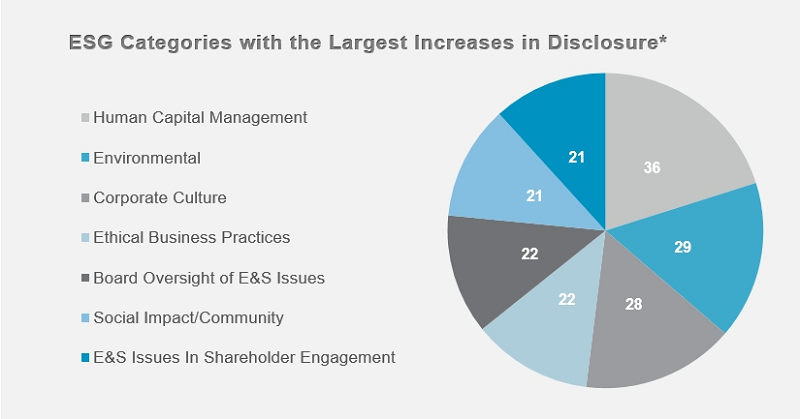
For further information, please visit the White & Case Coronavirus Resource Center.
These are unprecedented times, and companies are facing important issues as they navigate the current economic, political, and social climate. The COVID-19 pandemic and Black Lives Matter movement have put the spotlight on public companies' management of ESG issues like never before. This article reports the results of the White & Case Public Company Advisory Group's annual survey of ESG disclosure in SEC filings by the top 50 companies by revenue in the Fortune 100.
Business continuity, risk management, employee health and safety, diversity, and human capital management are ESG issues that have become priorities in recent weeks and months, and in 2020, such issues are frequently being addressed in U.S. Securities and Exchange Commission (SEC) filings. As further discussed in our take-aways, the decision whether to include ESG information in an SEC filing or instead provide it on a corporate website is a nuanced one that should be assessed with care.
2020 ESG Topics Take the Spotlight in Quarterly Reports
So far in 2020, employee welfare, health and safety and business continuity issues have taken the spotlight in quarterly reports filed with the SEC. For example, in first quarter 10-Q filings, 38 out of 50 top companies by revenue in the Fortune 100 (or 76%) included disclosure on employee health and safety. Nearly all of these disclosures referenced COVID-19 and measures companies were taking to protect and promote employee welfare. Many companies also highlighted their business continuity planning in disclosures in light of potential COVID-related disruptions.1 This disclosure was in line with recent SEC disclosure guidance in Topics No. 9 and 9A, which both emphasize the importance of disclosing material information regarding employee matters due to the pandemic, such as employees' transition to remote working arrangements, the modification of operations to comply with health and safety guidelines to protect employees, and constraints on human capital resources and productivity. The impact of COVID-19 on corporate operations cannot be overstated, and investors are interested in how companies are responding in terms of safety, logistics, and operational continuity.
Survey of ESG Disclosure - 2019 to 2020
The 2020 baseline of ESG disclosure in SEC filings, prior to the pandemic's impact on U.S. public companies, is reflected in annual meeting proxy statements and annual reports filed with the SEC by the top 50 companies2 by revenue in the Fortune 100. Our survey focused on 17 categories3 of common ESG related-disclosures in Annual Reports on Form 10-K and annual meeting proxy statements filed with the SEC in 2019 and 2020.4 The trends from our survey and key takeaways are discussed below.
Increase in ESG Disclosure from 2019 to 20205
Every company surveyed increased its ESG disclosures in at least one category in their proxy statements between 2019 and 2020, and 21 companies (or 42%) also increased their ESG disclosures in at least one category in their annual report on Form 10-K between 2019 and 2020. The most significant increases in ESG disclosure came in the seven categories described below.
The Seven ESG Topics on the Rise in 2020
*number of filings in which the disclosure in the relevant category increased
1. Human Capital Management (HCM)
In 2020, the largest increase in ESG disclosures came in human capital management. Overall, 45 of the 50 companies surveyed (or 90%) included some form of HCM disclosure in their 2020 Form 10-K or annual meeting proxy statement, representing an 8% increase from 2019. Moreover, 35 of the 2020 filings surveyed (or 70%) showed an increase in this type of disclosure from 2019. In the 35 filings where there was an increase in HCM disclosure, the disclosure was three times more likely to come in a proxy statement, as opposed to an annual report, and included the following6:
On Employee Diversity (in 29 of the 35 filings). For example: "We are proud that over 60% of our employees are women or people of color, that over half of our employees report to a woman or a person of color and that women and people of color represent more than 50% of our employees at or above the vice president-level… [S]ince the end of 2010, the number of women at or above the vice president-level has increased by more than 70%, and the number of people of color at or above that level has more than doubled."
On Employee Training/Talent Development (in 25 of the 35 filings). For example: "[We] offer a wide variety of career opportunities…and paths to advancement through on-the-job coaching, training, and education. We are proud to be a company where an associate can start in an entry-level job and turn it into a successful career."
On Employee Pay/Benefits (in 21 of the 35 filings). For example: "We have made significant investments in our U.S. hourly associates. For example, we stated in our 2019 ESG Report that: we had raised our starting wages in the U.S. over the prior three years; in fiscal year 2019, we had delivered approximately $793 million in bonuses to full- and part-time hourly associates in our [Company's U.S.] stores;…[and] we had opened nearly 200 [Company] Academies in the U.S. with hundreds of thousands of associates having been trained in these academies since the inception of the program."
On Employee Feedback (in 6 of the 35 filings). For example: "In 2019, the Company conducted the Our Voice Employee Survey. Our overall participation rate was 87%, 3% higher than in 2017. Our overall results have increased to 81% favorable."
Within HCM disclosures, there was also an increase in the amount of quantitative ESG disclosures in 2020 when compared with 2019. For example, of the 45 filings that included disclosure on HCM, 27 (60%) included quantitative metrics, such as information on: (1) the percentage of employees who are women or people of color, and (2) information on corporate investments to improve gender and ethnic diversity in their workforce. We expect quantitative disclosures to increase, as investors heighten their focus on diversity disclosures in 2020. In July 2020, the NYC Comptroller, on behalf of three New York City Retirement Systems with over $200 billion in assets, sent a letter to the CEOs of 67 S&P 100 companies calling on them to adopt a policy to publicly disclose diversity data with a comprehensive breakdown by race, ethnicity, and gender in 10 employment categories, including senior management, and provide a written commitment to do so by August 30, 2020 or face the risk of a proposal on this topic submitted to a shareholder vote.7
2. Environmental Matters
Twenty-nine of the 2020 filings (or 29%) increased their environmental disclosure from 2019. The increase in environmental disclosures was notable because it moved up from the fourth to the second spot in 2020 in terms of increases in ESG disclosure, signifying the heightened focus on environmental issues in 2020. Overall, nearly all of the companies surveyed (47 or 94%) included environmental disclosure in their 2020 Form 10-K and/or proxy statement, a 2% increase from 2019.
Investments in Environmental Sustainability (in 25 of the 29 filings). For example: "[The Company] is making significant investments in renewable energy and sustainability initiatives: Running on 100% renewable energy by 2030. [The company] has over 86 renewable energy projects, including 26 utility-scale wind and solar farms and 60 solar rooftops installed on fulfillment centers and sort centers around the globe;…Since 2008…[we] saved more than 810,000 tons of packaging material and eliminated the use of 1.4 billion shipping boxes…"
Climate Change (in 13 of the 29 filings). For example: "[The Company] demonstrates corporate leadership on climate change by setting strong goals and taking purposeful action in and outside our company. Our climate change strategy is based on mitigation, resilience and enablement. Progress Toward 2020 Targets: 60% Energy Intensity Reduction: 130% completed; 30% Fleet Emissions Reduction: 86.7% completed; Refurbish, reuse or recycle 200m devices: 87.5% completed" (Graphics).
Emissions Reduction Goals (in 14 of the 29 filings). For example: "[The Company] has invested nearly $10 billion in technology and programs to reduce emissions since 2000…These investments were key in eliminating or reducing CO2 emissions by more than 400 million tonnes, which is equivalent to the average annual energy demand of more than 46 million U.S. homes. The Company also announced, and is on track to meet, goals to further reduce emissions from its operations, including a 15-percent decrease in methane emissions and a 25-percent reduction in flaring by year-end 2020, as well as a 10-percent reduction in GHG intensity for the Imperial Oil-operated oil sands operations by 2023. These measures build upon established programs to deliver sustainable GHG reductions that help meet society's ambition for a lower-carbon future."
Renewable Energy (in 11 of the 29 filings) "Each year, we release a Supplier Responsibility Progress Report and an Environmental Responsibility Report, which disclose the efforts [the Company] has undertaken in achieving our goals regarding a host of different [ESG] issues. For example, we have delivered on our goal to cover 100% of our operations with 100% renewable electricity, and we have achieved a 35% reduction in our overall carbon footprint compared to 2015."
Increase in Environmental Quantitative Metrics. Within the environmental disclosures, there was also a significant increase in the amount of quantitative disclosures. Of the 47 filings that included environmental disclosure, 42 included quantitative metrics (up from 32 in 2019), such as information on greenhouse gas emissions reductions and renewable energy use. Recently, in the SEC's interpretive guidance on key performance indicators and metrics in MD&A disclosures8, the SEC specifically called out environmental metrics when reminding companies that, when including metrics in their disclosure, they should consider the need to include additional information necessary to provide adequate context so that the metric is not misleading.9 The increase in environmental disclosures by the surveyed companies in their SEC filings comes in a landmark year focusing on the "E" in ESG. Environmental shareholder proposals took center stage in shareholder proposals during the 2020 proxy season, with a meaningful increase in the number of environmental proposals submitted and in the level of support for such proposals.10 For example, 82 environmental proposals were submitted to S&P Composite 1500 companies in 2020, with 24 making it to a shareholder vote, an increase from 69 proposals in 2019 and 18 reaching a shareholder vote in 2019. Four of these environmental proposals received majority support this year, whereas none did in 2019.11
Moreover, just last month in July 2020, the Oil and Gas Climate Initiative (OGCI), a group that includes some of the largest oil & gas companies in the world, announced a target to reduce the collective average carbon intensity of member companies' aggregated upstream oil and gas operations to between 20 kg and 21 kg of CO2 equivalent per barrel of oil equivalent (CO2e/boe) by 2025, from a collective baseline of 23 kg CO2e/boe in 2017.
3. Corporate Culture
Twenty-eight of the 2020 filings surveyed (or 28%) increased disclosure on corporate culture from 2019. Overall, 43 of the companies surveyed (or 86%) included disclosure on corporate culture in their Form 10-K or proxy statement in 2020, a 6% percent increase from 2019.
Core Values (in 5 of 28 filings). For example: "Our Culture. The people of [our Company] are aligned around core values that inspire our behavior as individuals and as an organization. Integrity. Honor commitments. Never compromise ethics. Relationships. Build trust through collaboration. Compassion. Walk in the shoes of the people we serve and those with whom we work. Innovation. Invent the future and learn from the past…Demonstrate excellence in everything we do."
Importance of Board in Shaping Culture (in 8 of the 28 filings). For example: "Our strong tone at the top begins with our Board of Directors, which has demonstrated its focus on advancing openness, honesty, fairness and integrity in the Boardroom and across the Company…" Another company disclosed that its "Ethics, Conduct and Culture Committee [o]versees management's efforts to reinforce and enhance a culture of ethics throughout the firm."
4. Board Oversight of Environmental and Social Issues
Twenty-two companies (or 44%) increased disclosure on board oversight of E&S issues in their 2020 proxy statements. Overall, 44 companies (or 88%) included disclosure on board oversight of E&S issues in their 2020 proxy statements, a 2% increase from 2019. The increase in disclosure on board oversight of ESG issues was also notable because it moved up from the sixth to the fourth spot in 2020 for increases in ESG disclosure, signifying the heightened focus on this type of disclosure in 2020.
ESG Committee or Function Reporting to the Board (in 12 of the 22 filings). For example: "The Board established a Public Policy and Sustainability Committee in 2017 to assist the Board in providing more focused oversight over [the company's] policies, programs and related risks that concern key sustainability and public policy matters."
Governance Committee Oversight of E&S (in 7 of the 22 filings). For example: "During the past year, the Corporate Governance and Nominating Committee's oversight focused on, among other things… [the company's] Corporate Responsibility Report and trends (including environmental sustainability, climate risk, human capital, human rights issues, and political accountability), and investor outreach and feedback."
Committee with Oversight over ESG Matters. Of the surveyed companies, 11 (or 22%) disclosed that their Nominating and Corporate Governance Committee primarily oversaw ESG matters, while 25 indicated that ESG matters were overseen by a more specialized committee, such as a dedicated Sustainability Committee or a Public Issues and Contributions Committee. Additional companies disclosed that the board or various board committees share E&S oversight responsibilities.
5. Ethical Business Practices
Twenty-two of the 2020 filings surveyed (or 22%) increased their disclosure related to ethical business practices. Overall, 40 companies (or 80%) included disclosure on ethical business practices in their 2020 proxy statements, a 14% increase from 2019. Notably, in 8 of 21 filings with increased disclosure in this category, the disclosure noted recent expansions of shareholder engagement efforts on ESG issues, reflecting the heightened focus on ESG by investors.
Human Rights (in 5 of the 22 filings). For example: "[We] continue to drive ethical sourcing practices across our supply chain, protecting human rights, supporting diverse suppliers and engaging with suppliers around environmental issues."
Reporting Mechanisms/Protections (in 8 of the 22 filings). For example: "We are committed to creating an open and accountable workplace where employees feel empowered to speak up and raise issues. With this in mind, we provide multiple channels to speak up, ask for guidance, and report concerns."
6. Social Impact and Community
Twenty-one of the 2020 filings surveyed (or 21%), including 19 of the 2020 proxy statements surveyed (or 38%), increased their disclosure related to social impact and community relations, as compared to 2019. Overall, 45 companies surveyed (or 90%) included social impact and community relations disclosure in their 2020 filings, an 8% increase from 2019.
Charitable Giving (in 12 of the 21 filings). For example: "The Foundation works to improve the quality of education in the United States at all levels, with special emphasis on math and science. The Foundation also supports the Company's other cultural and public service giving."
Education (in 9 of the 21 filings). For example: "Since 2008, when we launched Aspire, we have committed more than $550 million in education-centric programs. Much of our work is in collaboration with organizations that help underrepresented students develop computer science and coding skills…"
Technology (in 5 of the 21 filings). For example: "[W]e are investing in building the next generation of technical leaders by providing broader access to STEM education. We have committed $50 million to support computer science and STEM programs for underserved and underrepresented communities."
7. E&S Issues in Shareholder Engagements
Twenty-one companies (or 42%) increased their disclosure related to ESG issues in shareholder engagements in their 2020 proxy statements. Overall, 40 companies (or 80%) included disclosure on ESG issues in shareholder engagements in their 2020 proxy statements, a 6% increase from 2019.
Responsiveness to Shareholder Feedback (in 18 of the 21 filings). For example: "During our meetings with shareholders we heard strong support for our new CEO and feedback regarding executive compensation. Our shareholders also expressed continued interest in the Board's oversight of opioid risks, the Company's ongoing compliance efforts to managing the opioid issue and clarifications to our Political Contributions and Lobbying Policy, including Board oversight. Informed by those discussions, we made the following changes to our governance and compensation practices…"
Expanded ESG Engagements (in 8 of the 21 filings). For example: "The Company values the views of its shareholders. Beginning in Fiscal 2018, the Company initiated an expanded ESG engagement program with institutional shareholders representing over 40% of our outstanding shares, and we continued that program in Fiscal 2019."
Mention of Specific E&S Issues Discussed (in 16 of 21 filings). For example: "In the fall of 2019 and into early 2020, we conducted a second round of engagement with stockholders representing about 28.0% of our outstanding shares in a series of meetings that focused on sustainability issues, including climate change and human capital management. In the area of human capital management, the topics included executive compensation practices, diverse representation in senior roles at [the company], talent development and succession planning, and identifying unintended biases in [the company's] people processes, including gender pay equity. Investors representing 4.5% of our outstanding shares declined our invitation to participate in the Fall/Winter engagement effort."
10-K vs. Proxy Statement Breakdown
ESG disclosure was more common in the annual meeting proxy statements of the surveyed companies than in annual reports on Form 10-K, with the increase in ESG disclosure approximately seven times more likely to come in a proxy statement than in a Form 10-K. In proxy statements, the greatest increases in disclosure were in the categories of (1) human capital management, (2) corporate culture, and (3) board oversight of ESG issues. With respect to Form 10-Ks, the ESG topics that saw the highest increases in disclosure were (1) environmental and sustainability matters, (2) human capital management, and (3) corporate culture and supply chain management (tied).
Qualitative vs. Quantitative E&S Disclosures
In the survey, we also reviewed whether the disclosure was only qualitative or both quantitative and qualitative in nature. We found that a majority of E&S disclosures in the SEC filings we reviewed were qualitative and did not provide quantitative metrics; however, certain E&S categories had more quantitative disclosure than others (for example, disclosure on environmental matters, HCM, E&S goals, and social impact and community relations were more likely to contain quantitative metrics, as compared to disclosure on corporate culture or ethical business practices ). Our survey also found that an increasing number of companies have added some quantitative information to their ESG disclosures in SEC filings, particularly with respect to certain categories, such as environmental matters and human capital management, and nearly every category saw some increase in quantitative disclosures from 2019.13 As noted in our take-aways below, a key question is also where any relevant quantitative ESG information will be provided – in a sustainability report or SEC filing.
Reporting Frameworks: SASB and TCFD
In their 2020 SEC filings, eleven of the surveyed companies (or 22%) disclosed in their annual meeting proxy statements or annual reports that they follow SASB and/or TCFD reporting guidelines in their sustainability reports posted on their websites.14 Of these eleven companies, six disclosed that they provide reports aligned with or informed by TCFD recommendations, four companies reported following or looking to both SASB and TCFD and one company reported following only SASB standards. In addition, one other company disclosed in its proxy statement that it plans to provide reports aligned with SASB in 2020.
This disclosure echoes the calls from the investor community, including BlackRock15, which has called on the public companies it invests in to publish disclosure in line with SASB and TCFD. It also aligns with the push from shareholder proposal proponents, who submitted at least seven proposals during the 2020 proxy season calling on companies to provide sustainability disclosure in line with SASB.16
Disclosed following SASB (5 of 11). For example: "We have worked, and are continuing to work, to integrate our ESG and SEC reporting and align our ESG disclosures with external frameworks such as SASB and TCFD"
Disclosed following TCFD (10 of 11). For example: "In 2017 the Financial Stability Board's Task Force on Climate-related Financial Disclosure (TCFD) issued its recommendations on reporting climate-related financial information. In September 2018, [we] published [our] climate report—under Board oversight led by the Nominating/Governance and Public Policy Committee—that is aligned with the main principles outlined in the recommendations of the TCFD."
Executive Compensation Ties to ESG Metrics
An additional trend is the use of ESG metrics to determine compensation of named executive officers ("NEOs"). Nineteen of the companies surveyed (or 38%) disclosed in their Compensation Discussion & Analysis sections of their proxy statements that they tied executive compensation to ESG metrics/goals in some way. While most of these disclosures mentioned non-specific sustainability or diversity performance, several noted specific environmental goals or workforce diversity metrics that linked directly to NEO compensation. For example:
Compensation tied to environmental goals (11 of 19 companies). For example: "ESG performance is a focus for the Company and our shareholders. The Compensation Committee factors ESG performance related to strategic goals for each NEO…reflect our ongoing commitment to ESG performance outcomes."
Specific ESG targets tied to NEO compensation determinations (8 of 19 companies). For example: "2019 Short-Term Incentive Compensation performance measures include Diversity and Sustainability Targets as follows: At least 60% of U.S.-based workforce comprised of minority and female employees; direct at least $5.2 billion of our overall supplier spending to minority- and female-owned firms; reduce our carbon intensity — the amount of carbon our business emits divided by the terabytes of data we transport over our networks — by at least 10% compared to the prior year."
Five Key Take-Aways
Given these considerations, when contemplating any ESG disclosure in connection with SEC filings, public reporting companies should give due consideration to the following key takeaways:
1. What's In and What's Out
Based on our survey, the top ESG topics for 2020 SEC filings were:
- Human capital management, which topped the list for the most increased disclosure for the second year in a row,
- Environmental, which moved up from fourth in 2019 to second in 2020, and
- Board oversight of E&S issues, which moved up from sixth in 2019 to fourth in 2020.
These top categories for increase (HCM, environmental, and board oversight) reflect the key areas of corporate and investor focus this year for the surveyed companies, which other public companies should consider enhancing in their own disclosures. In addition, ethical business practices did not make the top seven last year, but was number five in 2020. Although some categories decreased in prominence (social impact and community relations, and supply chain management), this does not necessarily reflect the relative level of disclosure on such topics, as companies may have already had robust disclosures on these topics and therefore did not increase those disclosures year over year.
2. SEC Filings vs. Sustainability Reports
The trend towards increased ESG disclosure in SEC filings is pronounced. Investors have increasingly focused on and called for ESG disclosure, and companies should assess their investors' policies and consider engaging with investors in order to determine which ESG information about their company is important to them. However, once a company knows what to disclose to its investor base, the nuance is to carefully consider where to place the ESG disclosure. Investors seeking ESG information do not necessarily expect any or all of that information to be presented in SEC filings, and sustainability disclosure on corporate websites can provide effective vehicles for this disclosure to investors. In 2020, 42 of the surveyed companies (or 84%) referred readers to sustainability disclosure on the company's website from their 10-K or proxy statement, and a growing number of surveyed companies are using their SEC filings to highlight to investors that they are providing enhanced ESG reporting (including SASB and TCFD-aligned disclosures) on their corporate websites. Moreover, it is important to acknowledge the continuing trend of companies providing most ESG reporting on corporate websites, rather than in SEC filings.
3. Monitor SEC Guidance
While there has been a strong push by some to impose mandatory ESG disclosures and integrate SEC filings with more ESG reporting,17 the SEC has thus far been opposed to the imposition of a mandatory ESG framework or other prescriptive sustainability disclosure requirements for SEC filings. For example, SEC Chairman Jay Clayton noted that E, S, and G are "quite different baskets of disclosure matters and that lumping them together diminishes the usefulness, including investor understanding, of such disclosures."18 Moreover, Clayton has noted that the nature of social and environmental components of ESG varies so widely from industry to industry and country to country that "in many areas we should not attempt to impose rigid standards or metrics for ESG disclosures on all public companies" as this would be "inconsistent with our mandate [and] would be a departure from our long-standing commitment to a materiality-based disclosure regime."19 The recent trend in the SEC's Disclosure Guidance in Topics 9 and 9A emphasizing particular topics that are ESG in nature, such as employee health and safety, for their inclusion in SEC filings, rather than "ESG" as a whole20, fits within the SEC approach of highlighting particular ESG topics that may be appropriate for inclusion in SEC filings, rather than "lumping" all of ESG into one disclosure bucket for purposes of SEC filings.
4. Focus on Materiality
In the end, the decision whether to include ESG information in an SEC filing or instead provide it on a sustainability website is a nuanced one and should be made with care. Public companies should be assessing ESG matters facing their businesses well in advance of their SEC filings and confirming whether any of these matters present material risks to their businesses that need to be addressed in SEC filings. When ESG information is not material, it may not be advisable to add the information to an SEC filing for a number of reasons, including the heightened liability risk with respect to disclosure that is filed with the SEC.21 Companies should therefore carefully weigh the risks and benefits when adding this type of disclosure to their SEC filings.
5. Above All, Make Sure Your ESG Disclosure is Accurate and Consistent
The ESG information that is disclosed in voluntary sustainability reports on corporate websites and SEC filings must be accurate and consistent. In fact, Division of Corporation Finance Director William Hinman has noted that the SEC is "actively" comparing the information companies voluntarily provide with the information disclosed in SEC filings. Accordingly, companies should take steps to ensure that they have controls in place to effectively process, summarize, assess, and review the accuracy of all of their ESG disclosures.
1 For more information, see our prior alerts, "SEC Emphasizes Importance of Robust Forward-Looking Disclosures to Address COVID-19" and "Practical Tips to Prepare for Upcoming Quarterly Disclosures."
2 The companies in this survey are the top 50 companies by revenue in the Fortune 100 that file proxy statements and Form 10-Ks. These companies consist of the following: Walmart, Exxon Mobil, Apple, Berkshire Hathaway, Amazon.com, UnitedHealth Group, McKesson, CVS Health, AT&T, AmerisourceBergen, Chevron, Ford Motor, General Motors, Costco Wholesale, Alphabet, Cardinal Health, Walgreens Boots Alliance, JPMorgan Chase, Verizon Communications, Kroger, General Electric, Phillips 66, Valero Energy, Bank of America, Microsoft, Home Depot, Boeing, Wells Fargo, Citigroup, Marathon Petroleum, Comcast, Anthem, Dell Technologies, DowDuPont (DuPont in 2020), Johnson & Johnson, IBM, Target, United Parcel Service, Lowe's, Intel, MetLife, Procter & Gamble, United Technologies, FedEx, PepsiCo, Archer Daniels Midland, Prudential Financial, Centene, Walt Disney, Sysco.
3 The 17 categories of E&S disclosure in this survey are the following: (1) Board Oversight of E&S Issues; (2) Corporate Culture; (3) Ethical Business Practices; (4) Human Capital Management; (5) Environmental Matters; (6) Social Impact and Community; (7) Political Contribution Disclosure; (8) Supply Chain Management; ; (9) E&S Qualifications of Directors; (10) E&S Issues in Shareholder Engagement; (11) E&S Goals; (12) E&S Disclosure in Proxy Statement Introduction Letters; (13) E&S Disclosure in Proxy Statement Summaries; (14) E&S Awards Disclosure; (15) References to Sustainability Website/Reports; (16) Follows SASB and/or TCFD; and (17) Executive Compensation Metrics Tied to ESG Goals.
4 The 2018-2019 White & Case LLP Survey is available here.
5 Rather than add substantive E&S disclosure to SEC filings, we note that many companies are increasingly providing significant disclosures on ESG topics in sustainability reports posted on their websites, including quantitative disclosures that align with frameworks such as the Sustainability Accounting Standards Board (or SASB) disclosure standards. Furthermore, we note that the results of this survey are not indicative of any position that a company should take with respect to its own SEC filings, and we encourage you to review the key takeaways and reach out to any member of the White & Case Public Company Advisory Group to discuss questions regarding your disclosure decisions.
6 Public company E&S disclosures vary significantly for a variety of reasons, and the disclosure examples included in this article are representative of the subjects covered within each applicable category. The examples of ESG disclosure in this memorandum are from the following companies (listed in order of appearance): Comcast Corporation, 2020 proxy statement; Walmart Inc., 2020 proxy statement; Walmart Inc., 2020 proxy statement; Chevron Corp., 2020 proxy statement; Johnson & Johnson, 2020 proxy statement; Amazon.com, 2020 proxy statement; AT&T Inc., 2020 proxy statement; ExxonMobil, 2020 proxy statement; Apple, 2020 proxy statement; UnitedHealth Group, 2020 proxy statement; Citigroup, 2020 proxy statement; Pepsico, 2020 proxy statement; Pepsico, 2020 proxy statement; Intel Corporation, 2020 proxy statement; Walgreens, 2020 proxy statement; Boeing, 2020 proxy statement; ExxonMobil, 2020 proxy statement; AT&T Inc., 2020 proxy statement; Amazon.com, 2020 proxy statement; McKesson Corp., 2020 proxy statement; Home Depot, 2020 proxy statement; Citigroup, 2020 proxy statement; Intel Corp., 2020 proxy statement; Valero Energy, 2020 proxy statement; General Motors, 2020 proxy statement; Verizon Communications Inc., 2020 proxy statement.
7 See the NYC Comptroller's letter, available here.
8 For more information, see our prior alert, "SEC Releases New Guidance on KPIs."
9 See Commission Guidance on Management's Discussion and Analysis of Financial Condition and Results of Operations (effective February 25, 2020), available here.
10 A substantial number of the climate-related disclosure proposals related to the Paris Agreement and GHG emissions. In addition, there were proposals relating to industry-specific climate risks, such as water-related risks at food and energy companies and stranded carbon assets at energy companies, as well as proposals to assess or report on the impact of particular sustainability initiatives implemented by the company.
11 Data for proposals submitted to and/or voted on at annual meetings of the U.S. members of the S&P Composite 1500, which covers over 90% of U.S. market capitalization, at meetings held on or before June 30, 2020. The data on submitted, withdrawn and voted-on shareholder proposals derives from ISS's voting analytics with respect to about 657 known shareholder proposals submitted this year to U.S. members of the S&P Composite 1500.
12 For example, in the 2020 filings surveyed, the following included quantitative disclosure on various topics: environmental matters - 42 filings; social impact and community – 32 filings; E&S goals – 32 filings; HCM – 27 filings; supply chain management – 12 filings; E&S highlights near the cover page of the proxy statement – 19 filings.
13 Increased quantitative disclosure in filings from 2019 to 2020 was found in the following categories: environmental matters – 42 filings in 2020 vs. 34 in 2019; E&S goals – 32 filings in 2020 vs. 26 in 2019; HCM – 27 filings in 2020 vs. 17 in 2019; social impact and community – 32 filings in 2020 vs 26 in 2019; E&S disclosure in introduction letters – 6 filings in 2020 vs. 4 in 2019; E&S highlights near cover page – 19 filings in 2020 vs. 15 in 2019; corporate culture – 7 filings in 2020 vs. 1 in 2019; ethical business practices – 3 filings in 2020 vs. 2 in 2019; E&S issues in shareholder engagements – 12 filings in 2020 vs. 6 filings in 2019; E&S qualifications of directors – 11 filings in 2020 vs. 6 in 2019; E&S awards – 11 filings in 2020 vs. 9 in 2019; board oversight of E&S issues – 1 filing in 2020 vs. none in 2019.
14 These companies were: Chevron, Ford, Alphabet, JP Morgan, Phillips 66, Bank of America, Home Depot, Citigroup, IBM, Intel and Prudential.
15 For more information, see our prior alert "Blackrock Calls for Enhanced Sustainability Disclosure and Accountability for Directors."
16 Two of these proposals were subsequently withdrawn due to commitments from the companies to provide SASB-aligned disclosure. See "A Successful Season for SASB Based Shareholder Resolutions," available here.
17 For example, on May 5, 2020, the SEC's Investor Advisory Committee recommended that the SEC "set the framework" for issuers to report on material ESG information. See the full recommendations here. Similarly, Sen. Mark Warner called on the SEC to establish an ESG Task Force to establish a "robust set of quantifiable and comparable ESG metrics that all public companies can adhere to." Potential principles-based ESG disclosure guidance from the SEC is characterized in Warner's release as "a step in the right direction," but not sufficient because a principles-based disclosure scheme inherently encompasses company-specific judgments and decision-making about what should be disclosed. In addition, a rulemaking petition was recently filed by Impax Asset Management LLC, requesting that the SEC "require that companies identify the specific locations of their significant assets, so that investors, analysts and financial markets can do a better job assessing the physical risks companies face related to climate change." The petition is available here.
18 See statement by SEC Chairman Clayton's statement at the investor advisory committee meeting (May 21, 2020, available here.
19 See "SEC Chief Takes on Short-Termism and ESG", Directors & Boards, available here.
20 Disclosure Topic 9 is available here and Disclosure Topic 9A is available here. SEC Commissioner Roisman recently expressed similar reservations about prescriptive requirements, emphasizing that companies should focus on materiality and that liability considerations should encourage appropriate disclosure. Commissioner Roisman's speech is available here.
21 In addition to Section 10(b) and Rule 10b-5, which are applicable to all public disclosures, Rule 14a-9 of the Securities Exchange Act of 1934, as amended (the "Exchange Act") and Section 18 of the Exchange Act impose heightened liability risks for false and misleading statements filed with the SEC in proxy statements and annual reports, respectively.
This publication is provided for your convenience and does not constitute legal advice. This publication is protected by copyright.
© 2020 White & Case LLP






